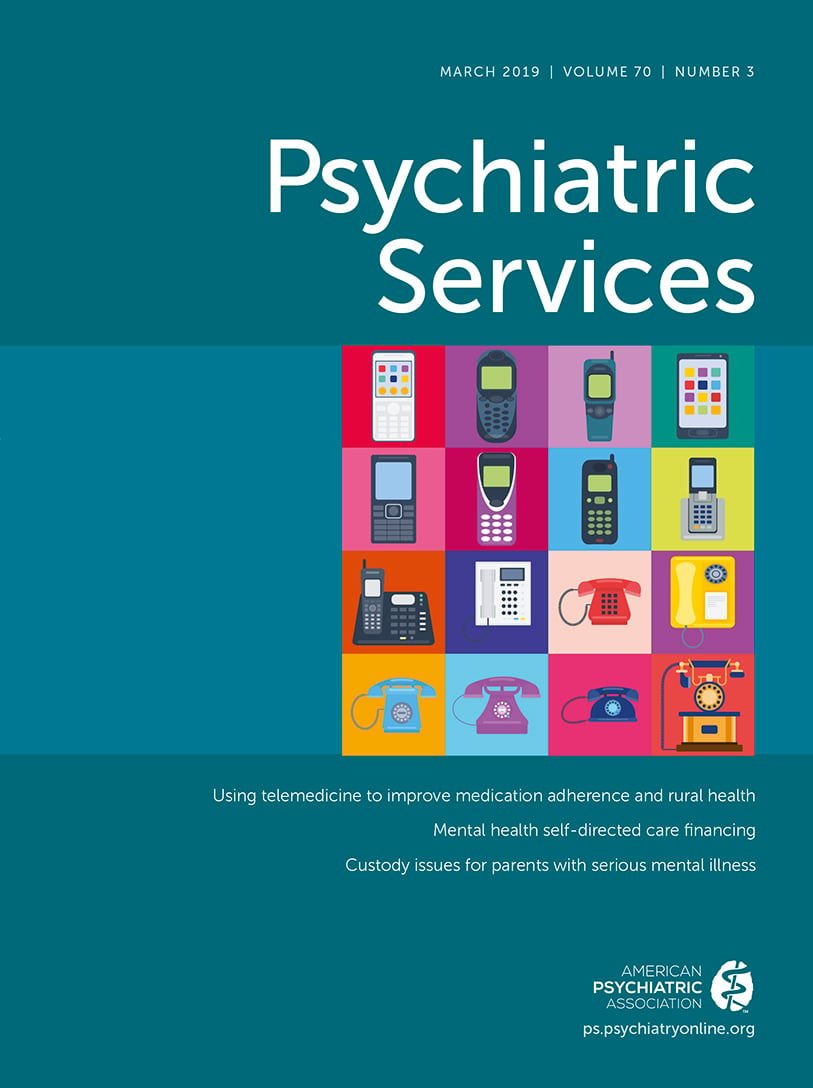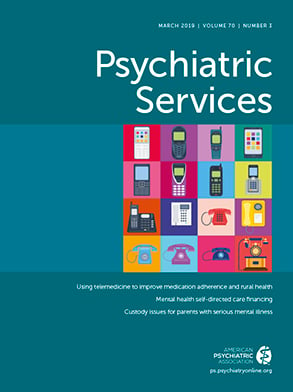Like many states, New York has pursued an aggressive agenda of Medicaid reform. Between 2012 and 2017, the state implemented the Health Home program and the Delivery System Redesign Incentive Payment program, carved all behavioral health services into Medicaid managed care plans, and created fully integrated special needs plans for over 150,000 individuals with serious mental illness, substance use disorders, or both. The state also committed to value-based payment arrangements for 80%–90% of all managed care plan payments to providers by 2020 (
1).
Each of these reforms included requirements for linking managed care plan and provider payments to quality-of-care measures. As various state government, provider, and advocacy groups began to examine data describing care plan cost and quality, they uncovered a common scenario: 20% of state Medicaid recipients with a behavioral health condition were responsible for over 50% of total Medicaid health care costs (
2). The recognition that behavioral health conditions are major factors in health care costs and outcomes stimulated great interest in quality and performance measures of behavioral health that could be included in value-based reforms. There was, however, a paucity of accepted measures of quality of care and of outcomes for individuals with behavioral health conditions. As of 2015, fewer than 50 of the over 700 measures endorsed by the National Quality Forum addressed behavioral health (
3). Additionally, many endorsed measures that address behavioral health focus on quality of care for general medical comorbidities, such as diabetes and cardiovascular disease, which are seen in a minority of individuals with behavioral health conditions. Finally, despite widespread recognition of the high rates of co-occurring chronic medical and behavioral health conditions, few measures can drive the integration of general medical and behavioral health services (
4).
The three state government agencies that share oversight for the New York State Medicaid program were tasked with collaboratively addressing these quality and performance measurement gaps. The agencies included the State Department of Health and two behavioral health oversight agencies—the Office of Mental Health (OMH) and the Office of Alcoholism and Substance Abuse Services. All three agencies recognized the need for a robust behavioral health measurement program to support the state’s reform initiatives; however, expertise, priorities, and incentives varied by agency, which created significant challenges. The State Department of Health had abundant experience with measure testing and implementation with managed care plans and hospital networks, although it lacked behavioral health content expertise. The State Department of Health managed other measurement programs related to non–behavioral health populations and was committed to a strict timeline for implementing new measurement programs to ensure the Centers for Medicare and Medicaid Services funded the reform initiatives.
The state behavioral health oversight agencies had a comprehensive understanding of the behavioral health provider and funding landscape but had little experience testing and implementing quality and performance measures at the population level. The behavioral health oversight agencies also shared concerns about the ways the multiple reform initiatives might affect the integrity of the state’s behavioral health provider system. The state system included many small- and medium-sized behavioral health providers with limited experience with outcomes measurement, electronic health records (EHRs), and value-based payment initiatives, making them vulnerable to exclusion in a system that increasingly relies on health information technology, data sharing, and alternative payment models. The behavioral health oversight agencies were hoping to leverage the multiple Medicaid reforms to help the behavioral health service system become more integrated, community based, and recovery oriented. The agencies also had diverging priorities: the State Office of Alcoholism and Substance Abuse Services, addressing the opioid epidemic, favored a strong focus on access to care, especially medication-assisted treatments, while OMH prioritized promoting access to recovery-oriented services to enhance employment, educational, and independent-living outcomes for individuals with serious mental illness.
In summary, there were multiple cross-agency obstacles to collaboration that were related to differing staff resources, agency priorities, and levels of expertise. Senior staff from each of the three agencies, who had been meeting regularly for 5 years as part of the state’s Medicaid Redesign Team (
5), identified three critical goals for a collaborative effort. First, a cross-agency team was needed to make timely final decisions about quality measures to be used in state and federal programs. Second, each of the two behavioral health agencies needed to preserve their independence and specific oversight responsibilities related to quality and performance. Third, innovative and flexible approaches to development of behavioral health quality measures needed to be supported and encouraged. The first goal was addressed when the State Department of Health created a cross-agency, multistakeholder behavioral health clinical advisory group, which was co-led by the behavioral health oversight agencies. The advisory group included representatives from key provider, advocacy, and trade association stakeholders and was charged with proposing a set of quality measures for the state’s pilot program for value-based payment for populations with serious mental illness. This program had to meet specific federal requirements within defined timeframes, which required the three agencies to commit to timely review and decision making. For this initial effort, the behavioral health oversight agencies agreed to focus primarily on established, endorsed, behavioral health quality measures vetted by Department of Health staff with substantial experience and expertise in quality measurement. A portfolio of standard behavioral health quality measures was adopted over 12 months with an agreement to review and revise annually.
To preserve oversight roles and support innovation, each of the two behavioral health oversight agencies developed intra-agency performance measurement programs that prioritized work on new behavioral health measures related to access and engagement in care, social determinants, functioning, and quality of life. The State Office of Alcoholism and Substance Abuse Services worked with the National Center for Addiction and Substance Abuse to convene an advisory committee of addiction care providers, Medicaid managed care plan representatives, and researchers. On the committee’s advice, the State Office of Alcoholism and Substance Abuse Services collaborated with measurement experts from the Department of Health to write specifications for and test the validity of quality-of-care measures assessing both the transition from inpatient to community-based substance use treatment services and ongoing outpatient engagement in care.
OMH convened a panel of outside experts for a day-long meeting to establish a framework for its measurement development activities. In April 2017, the Center for Practice Innovations—an OMH-supported provider of technical support and training in evidence-based practices to state behavioral health providers—convened a meeting of the New York State Behavioral Health Performance Measurement Expert Panel. The 57 invited panelists included national behavioral health services research and policy experts, state policy stakeholders from the oversight agencies, key state behavioral health provider leaders, and consumer advocates. The meeting began with presentations by national experts on behavioral health performance measurement, followed by an overview of the state’s behavioral health care system and Medicaid reform initiatives. Members then split into three work groups that focused on priority topics identified by a planning group. [A summary report of the expert panel’s findings and recommendations is available as an online supplement.]
One of the panel work groups focused on the state’s data infrastructure for performance measurement. Like most states, New York has a tremendous amount of data; however, existing databases are not linked, and the lack of interoperability greatly limits quality and performance measurement initiatives. Also, the lack of uniform health information technology standards is a major impediment to effective data sharing from EHRs. Many small- and medium-sized behavioral health providers lack the financial and technical resources to implement EHRs and are further restricted by informed consent regulations that create significant obstacles to data sharing. The work group recommended prioritizing strategies to leverage existing state data sets and information platforms, including providers’ EHRs, to support behavioral health performance measurement and quality improvement activities for both children and adults. Examples of recommended activities included creating summary reports of state and national practices for using administrative and EHR data to report behavioral measures; stratifying state managed care data by behavioral health populations to identify new measures of behavioral health service access and utilization; and collaborating with criminal justice, housing, and education authorities to link their databases to health platforms.
The second work group focused on promoting the integration of general medical and behavioral health services. Successful implementation of integrated care models requires rigorous monitoring of processes and outcomes. There are many more endorsed behavioral health process measures than endorsed outcome measures, and robust debate endures about the merits of focusing solely on outcome measures (which can incentivize adverse selection of patients) versus also emphasizing process and fidelity measures (which can limit provider flexibility and innovation) (
6,
7). Measurement programs should aim to support clinical decision making as well as quality and performance measurement. The work group recommended that the state examine quality and performance measures for integrated care interventions and propose modifications to promote uptake of integrated care models in the State Medicaid Program. Examples of recommended activities included preparing data reports that summarize the reliability, validity, and feasibility of current and potential quality and performance measures for integrated care, developing guidelines and technical assistance resources for integrated care to be considered in state value-based payment arrangements, and identifying new measurement opportunities for behavioral health disorders other than depression.
The third work group focused on functioning and recovery measures. Many behavioral health conditions contribute directly to functional deficits in employment and education status, social connectedness, quality of life, and independent living skills. Additionally, behavioral health providers increasingly use evidence-based interventions, such as motivational interviewing and supported employment, to improve functional deficits and achieve person-centered goals. The work group noted that reliable and valid measures of functioning and recovery exist and should be considered for measurement programs. The group also recommended establishing a process for testing and evaluating nonendorsed measures on their readiness to be included in value-based payment arrangements. Examples of specific recommended activities included summarizing measures of functioning and recovery in use in New York and other states; using a participatory process to convene stakeholders, identify key recovery metrics, and prioritize functioning and recovery metrics for consideration; establishing procedures for using new, nonendorsed measures in value-based payment arrangements; and reviewing existing literature to offer recommendations about implementing measures of equity of care.
In the final session of the day, the work groups discussed their findings with the larger group. Panelists noted that federal oversight priorities are shifting to grant states greater authority and flexibility to manage their health care programs. Based in part on recommendations of the invited experts, OMH subsequently created the Behavioral Health Integrated Performance Measurement Center to implement the panel’s recommendations and support the state’s behavioral health clinical advisory group.
To document the collaborative efforts under way, the state oversight agencies drafted a memorandum of understanding describing the activities and roles and responsibilities each agency will maintain as the state continues its reforms. The New York State Medicaid program is a large and important system of care that can serve as a model for other states. This column describes the effort among multiple state oversight agencies to overcome barriers to accomplishing both shared and distinct goals across agencies with diverging priorities and resources. The resulting collaboration has spurred interest and motivation among a broad range of stakeholders and created a path forward to ensure that rapid Medicaid reform will be supported by coordinated, state-of-the-art behavioral health performance measurement.

